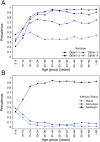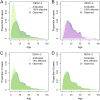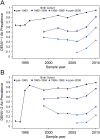Incomplete Protection against Dengue Virus Type 2 Re-infection in Peru
- PMID: 26848841
- PMCID: PMC4746126
- DOI: 10.1371/journal.pntd.0004398
Incomplete Protection against Dengue Virus Type 2 Re-infection in Peru
Abstract
Background: Nearly half of the world's population is at risk for dengue, yet no licensed vaccine or anti-viral drug is currently available. Dengue is caused by any of four dengue virus serotypes (DENV-1 through DENV-4), and infection by a DENV serotype is assumed to provide life-long protection against re-infection by that serotype. We investigated the validity of this fundamental assumption during a large dengue epidemic caused by DENV-2 in Iquitos, Peru, in 2010-2011, 15 years after the first outbreak of DENV-2 in the region.
Methodology/principal findings: We estimated the age-dependent prevalence of serotype-specific DENV antibodies from longitudinal cohort studies conducted between 1993 and 2010. During the 2010-2011 epidemic, active dengue cases were identified through active community- and clinic-based febrile surveillance studies, and acute inapparent DENV infections were identified through contact tracing studies. Based on the age-specific prevalence of DENV-2 neutralizing antibodies, the age distribution of DENV-2 cases was markedly older than expected. Homologous protection was estimated at 35.1% (95% confidence interval: 0%-65.2%). At the individual level, pre-existing DENV-2 antibodies were associated with an incomplete reduction in the frequency of symptoms. Among dengue cases, 43% (26/66) exhibited elevated DENV-2 neutralizing antibody titers for years prior to infection, compared with 76% (13/17) of inapparent infections (age-adjusted odds ratio: 4.2; 95% confidence interval: 1.1-17.7).
Conclusions/significance: Our data indicate that protection from homologous DENV re-infection may be incomplete in some circumstances, which provides context for the limited vaccine efficacy against DENV-2 in recent trials. Further studies are warranted to confirm this phenomenon and to evaluate the potential role of incomplete homologous protection in DENV transmission dynamics.
Conflict of interest statement
The authors have declared that no competing interests exist.
Figures




References
-
- Sabin AB. Research on dengue during World War II. Am J Trop Med Hyg. 1952;1: 30–50. - PubMed
-
- Montoya M, Gresh L, Mercado JC, Williams KL, Vargas MJ, Gutierrez G, et al. Symptomatic versus inapparent outcome in repeat dengue virus infections is influenced by the time interval between infections and study year. PLoS Negl Trop Dis. 2013;7: e2357 10.1371/journal.pntd.0002357 - DOI - PMC - PubMed
Publication types
MeSH terms
Substances
Grants and funding
LinkOut - more resources
Full Text Sources
Other Literature Sources
Medical

